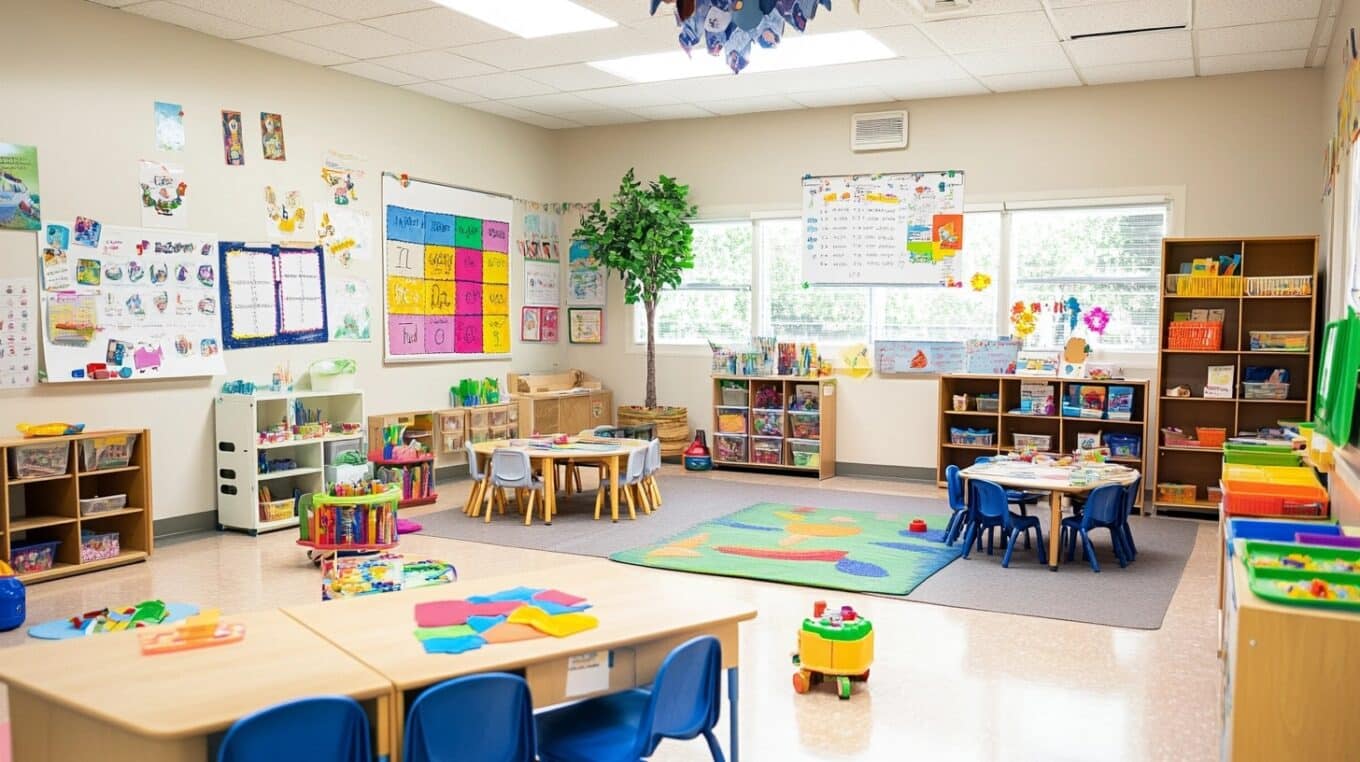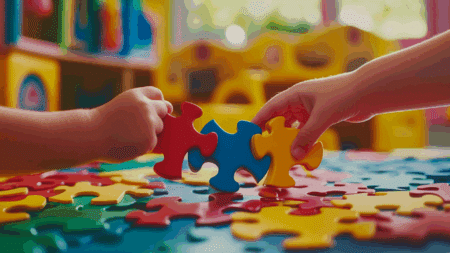Is your kindergarten schedule feeling chaotic instead of calm? Many teachers find it tough to balance learning and play for young kids.
It is possible to create a schedule that keeps kids focused while also giving them time to move and rest.
This guide explains a proven daily schedule that works in real classrooms – from the morning routines to afternoon activities.
You’ll learn how to adjust the schedule for students with special needs, manage changes smoothly, and include fun activities that make learning exciting.
If you’re a new teacher or simply seeking fresh ideas, these tips will help you establish a daily schedule that works for both you and your students.
Kindergarten Daily Schedule Breakdown
A full-day kindergarten schedule balances active learning with quiet time, helping young children adjust to school life while building key skills.
Most kindergarten days run from around 8:00 AM to 3:00 PM, with each part of the day serving a specific purpose in child development.
The morning typically focuses on core academic subjects when children are most alert, while afternoons include more movement and creative activities.
This balanced approach helps five and six-year-olds learn to follow routines while still honoring their need for play and rest.
Morning Activities
Begin the day with activities that help children settle in and prepare to learn.
This includes arrival routines, quiet time, and fun group activities like morning meetings to engage them.
Arrival and Quiet Activities
The day begins with a gentle transition from home to school.
As children arrive (usually between 7:45-8:15 AM), they hang up coats, put away folders, and choose from calm activities like looking at books, coloring, or working with puzzles.
This soft start gives teachers time to welcome each child personally and helps students ease into the school day.
Morning Meeting
Once everyone has arrived, children gather for a morning meeting (typically 15-20 minutes).
This important community-building time includes greeting each other by name, checking the calendar, and checking the weather.
Counting days of school, reviewing the day’s schedule with visual cards, sharing time for students to tell short stories or show special items, and a quick group activity or song.
This daily ritual builds classroom community and helps children feel secure in knowing what comes next.
Structured Lessons
The mid-morning block (usually 9:00-11:30 AM) is when most academic instruction happens.
During this time, language arts includes read-alouds, letter recognition, and basic writing practice. Math focuses on counting, patterns, shapes, and hands-on activities with manipulatives.
Phonics instruction helps children connect letters with sounds through games and activities.
Small group work allows teachers to work closely with a few students while others practice skills at centers.
Teachers break these lessons into 15-20 minute segments with movement breaks in between to match young children’s attention spans.
Afternoon Activities
Afternoon activities keep kids refreshed and focused.
After lunch and recess, children engage in small-group work, creative classes like art, and quiet time, ensuring they remain active and engaged.
Snack and Recess
Midday brings much-needed food and outdoor time. A healthy snack helps refuel growing bodies, while recess (usually 20-30 minutes) provides fresh air and sunshine.
A chance to use outdoor voices, physical activity on playground equipment, social practice through games and free play, and time to run, jump, and move after sitting still.
For many kindergartners, this free play period is a highlight of their day.
Independent or Small-Group Work
After recess, children often work in rotating centers or small teacher-led groups for guided reading practice with leveled books, phonics games that reinforce morning lessons.
Hands-on math activities, writing practice and storytelling, and science and social studies explorations.
This format allows teachers to check in with each student while others practice working independently.
Specialist Classes
Most schools include special area classes in the afternoon schedule.
These might include art (exploring materials and basic techniques), music (singing, moving to rhythms, playing simple instruments), physical education (developing coordination and learning game rules), and library (choosing books and hearing stories).
These classes typically last 30-45 minutes and may rotate throughout the week rather than occurring daily.
Rest Time and Quiet Activities
Many full-day kindergarten programs include a short rest period (10-20 minutes) where children relax on mats or carpets.
This isn’t necessarily nap time, but a chance to recharge with soft music playing, looking at books independently, listening to a recorded story, or quiet coloring or drawing.
This downtime helps children manage the long school day and prepares them for the afternoon.
Customizing Your Kindergarten Schedule
Adapt your kindergarten schedule to match your specific classroom needs. For special needs students, add extra support during transitions and provide visual schedules.
Help English language learners with visual cues and buddy pairings. Always observe how students respond to different activities and adjust timing accordingly.
Flexibility in the Daily Routine
Build planned flexibility into your consistent routines. Extend activities by 5-10 minutes when students show deep engagement.
Create 3-5 minute buffer zones between activities for students who need processing time. Use visual timers that students can monitor (sand timers, color-coded clocks) to build time awareness.
Offer choice within the structure, allowing different starting points as long as all tasks are completed. Schedule regular check-in times to assess which parts of your routine need adjustment.
Handling Changes Smoothly
Make changes between activities clear and manageable. Use consistent signals (such as songs, chimes, or visual cues) to mark the beginnings and endings of activities.
Give five-minute and one-minute warnings before transitions. Turn necessary changes into playful moments, such as animal movements and counting games.
Create visual supports near transition areas that show the steps for routine tasks. Assign change helpers to each peer on a weekly basis to assist those who find changes difficult.
Keep changing materials organized and accessible to prevent learning time loss. Allow extra time for students who require additional support during activity changes.
Activities and Ideas to Enhance the Kindergarten Day

Add variety to the day with fun and engaging activities. These can include play-based learning, creative arts, and hands-on projects to keep students interested and excited to learn throughout the day.
Engaging Phonics Activities
Shape letters with playdough or trace them in sand to build muscle and visual memory. Create a “letter of the week” box with objects starting with the target sound.
Play “sound swat,” where children hit letter cards that match word beginning sounds. Add movement to worksheets by having children hop to find matching sounds or go on classroom “sound hunts.”
Math Made Meaningful
Count steps, sort lunch items, and measure classroom objects to connect math to daily life. Set up a classroom store with play money to practice counting and one-to-one correspondence.
Use snack items for sorting and patterns. Play “Roll and Build,” where children roll dice and make block towers to match the number.
Play-Based Learning Centers
Change dramatic play areas into post offices where children write, count stamps, and sort mail. Add measuring tools and clipboards to block centers for spatial learning.
Hide academic items in sensory bins – letter beads in rice or shape cutouts in water. Turn science activities into investigations where children record findings through drawings.
Music and Art as Learning Breaks
Use movement songs like “Freeze Dance” between lessons to refresh minds. Create rhythm patterns by clapping or using classroom instruments to build sequencing skills.
Plan quick art activities that strengthen fine motor skills needed for writing. Connect music with counting through number songs to make sequences memorable.
Final Thought
By balancing structured learning with playful exploration, you create an environment where young children can develop academically, socially, and emotionally.
The perfect schedule includes flexibility, adjusting for your unique students while maintaining helpful routines.
The morning focus on academics, midday movement breaks, and afternoon creativity outlined in this guide provide a framework you can adapt.
As you implement your kindergarten daily schedule, watch how students respond and be willing to make changes.
When children know what to expect yet still experience joy in learning, you’ve found the right balance for kindergarten success.




